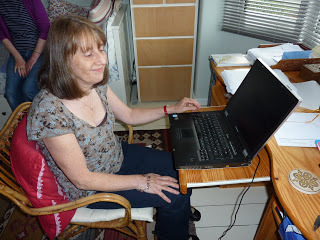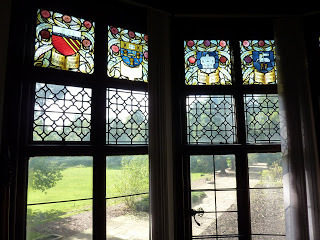Martin Edwards's Blog, page 279
October 10, 2010
Thorne: Sleepyhead - review
Thorne: Sleepyhead is a three-part crime show introducing Mark Billingham's cop Tom Thorne to the small screen. This was Billingham's first book, and it's a striking start to a TV series, just as it was a striking fictional debut.
David Morrisey, whom I best remember as the dodgy politician in State of Play (TV version, not the film) plays Thorne. He's confronted with a serial killer, who specialises in giving his luckless victims strokes. One young woman who succumbs does not die, though, and as she lies helplessly in hospital, Thorne tries to communicate with her. But is he playing the killer's game?
The episode ended in dramatic fashion, and I'll certainly be tuning in next week. Mark Billingham has not had as long to wait for TV success as Peter Robinson, but there are some similarities with DCI Banks. A tall, moody cop with a troubled private life, falling for a glamorous blonde professional. A series of savage murders. And so on. It really is quite hard to do something new in television crime, but Thorne made a good stab at it.
I first met Mark Billingham about ten years ago, at a crime convention in Manchester, when we sat next to each other at a gala dinner. He was charming and witty and very keen on the genre - I recall he collected Ian Rankin first editions. At that time, he was still unpublished, but he struck me as someone determined, and likely, to succeed. He's certainly done that, and I am sure he must be delighted to see Thorne on the box.
The Murder and Mr Akroyd
Last Monday evening, I hosted my Victorian murder mystery at Akryod Library, Halifax. It was an enjoyable occasion, and I found the venue especially fascinating. The library shares premises with Bankfield Museum, and the building is in a park – unfortunately, it was too dark for me to look around much outside.
But there were some treasures inside, including information about the long defunct Halifax Literary and Philosophical Society – a name that greatly appealed to me. The exhibits included the Halifax Gibbet, a truly fearsome means of execution. I was told it was a precursor to the guillotine. I'm not sure about the historic details, but I did wonder if gibbets had featured much in detective fiction – I imagine so, but can't call any example to mind.
Bankfield Mansion was once home to a leading Yorkshire worsted and wooleen manufacturer – Edward Akroyd. He developed it into a palatial Italianate-style home. The original Library is one of the most impressive of the rooms. It still retains original oak bookcases, and a great marble fireplace. At one time Akroyd had a staff of 25 servants working at the house. But business problems forced him to sell Bankfield, and the Halifax Corporation took it over, creating the public museum and library. I'd never have gone to Bankfield had I not been invited to host the mystery evening. Yet another example of the unexpected pleasures that can come a writer's way.
One more bit of news, by the way. Take My Breath Away will make its appearance in a US edition, published by Five Star, next June. I'm really pleased, as it is a book I remain proud of.
October 8, 2010
Writers at Work


I am always fascinated to see the places where other writers live and work. When – twenty years ago, I can hardly believe it! - I first visited Greenaway, where Agatha Christie lived, I was greatly intrigued, and I mentioned a while back my pleasure at visiting Margaret Yorke in her delightful cottage, with a study crammed with books. And Eileen Dewhurst, now retired but a Wirral based writer of note, has a great set-up in her flat in Birkenhead.
Closer to home in Cheshire, Kate Ellis has for many years worked out in the garden in a specially designed garden room. But now she's moved her study and workplace indoors. She is a gifted plotter, and it's fascinating to see how she maps out her intricate mysteries in a very visual way. This is something I don't do, but it's a method that has a good deal to commend it, I think. And the success of Kate's ingenious puzzles shows that it works very well in accomplished hands.
What Kate and I do have in common as writers is that we both know the solution to the main mystery from the outset. My own starting point is almost invariably an interesting motive for murder. And that is why I am not one of those crime writers who does not know where the story is going to wind up when they begin writing. But all methods are valid – they are simply a means to an end. What really matters is the quality of the end product.
October 7, 2010
Forgotten Book - The Complete Curious Mr Tarrant
My entry today for Patti Abbott's series of Forgotten Books is a collection that updates a book of short stories that is fondly remembered, I think, by a fair number of Golden Age fans. This is The Complete Curious Mr Tarrant, a Crippen & Landru 'lost classsic' which expands The Curious Mr Tarrant, first published in 1935.
The author, C. Daly King, was a psychologist, who wrote on his professional subject as well as venturing into detective fiction in half a dozen novels, some of them now fabulously rare in first edition. I'm still trying to trace Careless Corpse – in any edition. His plotting was labyrinthine, and occasionally eccentric. Obelists Fly High, which I've discussed before, is a truly remarkable mystery novel, well worth seeking out.
The original book of stories about Trevis Tarrant were not published in King's native US until the 70s, but they deserved a better fate, and the expanded book, dating from 2003, contains four additional tales – fascinating finds, making the collection a true cabinet of curiosities. There is a nice introduction by the late Edward D. Hoch, who speaks fondly of King's ingenuity, and his penchant for impossible crime stories.
The book offers 'headless torsos, a haunted house, a vanishing harp, a museum mystery and other delights', as Hoch says, along with a story about a murder solved only by the absence of a fish. 'The Episode of the Nail and the Requiem' was admired and anthologised by Dorothy L. Sayers, who knew a clever writer when she saw one. These stories are dated and sometimes quite barmy, but for me they have an irresistible appeal. What a shame that King's one and only novel about Tarrant never saw the light of day.
October 6, 2010
Finding a new author
I knew nothing of Gunnar Staalesen until I read Yours Until Death, which I reviewed for Tangled Web UK, and more briefly for this blog the other day. But he is certainly an interesting writer. Born in 1947, he published his first book at the tender age of 22. His titles include At Night All Wolves are Grey – terrific title! An author I shall look forward to revisiting.
It's always a good feeling when you find an author new to you whose books really appeal. It's even better in a way if they have been around for a long time, since then you know that there are plenty of other titles to devour. Of course, they may not all be of the same standard, but most good writers are worth reading even when below their best.
Over the years I've made plenty of such discoveries. Among those I remember with great pleasure are Cornell Woolrich, whom I first encountered in the early 80s, and the great Frenc duo, Boileau and Narcejac, whom I first read about four years ago, though I'd seen Vertigo many years earlier. And reading Ruth Rendell for the first time was another great experience - I started with A Judgement in Stone, still one of the best novels of psychological suspense that I've ever read. I can even remember reading some of it in Kew Gardens, of all places...
Equally, I must admit that I get a kick out of reviews where someone has come across my work for the first time, and expresses enthusiasm for reading more of my work. This means a lot to a writer, and such a response always puts me in a good mood for the rest of the day! On the subject of reviews, by the way, I have now updated the Lake District Mysteries page on my website which contains reviews of The Serpent Pool. Reaction to that book has exceeded even my expectations, and I'm truly delighted by the critiques. The publishers tell me the paperback is due out in January - looking forward to it!
October 5, 2010
Unpleasant characters in a mystery
It's fair to say that a good many modern crime novels seem to be populated with an array of unpleasant characters. But even where you have a book with (say) an appealing detective, it's quite common to find that the characters you dislike are in the great majority. But is this inevitable?
In a whodunit, you need to have a range of people who might conceivably have committed the murder. Years ago, common motives were inheritance, and the difficulty of obtaining a divorce. Plenty of books featured people who seemed amiable, even though they turned out to be murderously inclined. The culprit in Agatha Christie's The ABC Murders is but one example.
But nowadays, motives are (I suggest) more often rooted in character flaws than perhaps was the case in the past. And perhaps this means that the characters themselves are unlikely to be attractive, at least below the surface.
It's an issue that vexes me with my own books. One of my recent novels therefore was based on the premise that an appealing person might have a good reason to commit a terrible crime. But more often, I find that almost all my suspects have their dark side. This is true of The Serpent Pool , for instance. And I do wonder about the views of readers. Is it enough to have a small number of appealing characters? Or do you like the (seemingly) nice guys to be in the majority – and, if so, how do you respond when one of them turns out to be a murderer? Or does it really not matter, as long as the story holds your interest?
October 4, 2010
DCI Banks - review of Aftermath, part 2
DCI Banks – Aftermath concluded last night and having had a look at other reviews, I'm a bit worried that I seem to be in something of a minority in having enjoyed the opener for this new series starring Stephen Tompkinson as Banks and Andrea Lowe as Annie Cabot. But despite widespread reservations about the portrayal of Banks as a bit of a wimp, I found the second and concluding episode fairly entertaining and a bit different from many TV cop shows.
However, there was a heavily melodramatic element to the material and its presentation, and here perhaps there were too many concessions in the script to the perceived requirements of a TV audience. I've read many of the Banks books, but not Aftermath, so I can't comment with authority, but even so I'm confident the novel is a good deal subtler than the screenplay.
Of course, it is in the nature of TV adaptations that they lose something of the flavour of the original. If the writer is lucky – think Colin Dexter – they add a lot, too. But Liza Cody, Tim Heald and Marjorie Eccles are among those who arguably were not well served when their books made the transition to the small screen. And even Reg Hill had to endure Hale and Pace as the original Dalziel and Pascoe, before his work moved to the BBC.
John Harvey, in a rather scathing assessment of the first episode of Aftermath, mentioned that Tompkinson was once briefly considered for the role of Charlie Resnick. It's also the case that he was mooted for a TV version of Harry Devlin, and a script of All the Lonely People was written by one of the scriptwriters for Taggart. Alas, it never got made. Would I have minded liberties being taken with my masterpiece? Believe me, I could have coped!!
October 3, 2010
Abney and Agatha



English Heritage week-end saw Abney Hall's interior opened for visitors, a rare event that attracted crime writer Kate Ellis and her husband Roger, who live nearby, and who invited us over to have a look at this fascinating place. The trip was, in fact, a few weeks back, but it's taken me an age to get used to downloading photos from my new camera!!
I've mentioned Abney before. It was once the home of Agatha Christie's sister. She married into a very wealthy Mancunian business family, the Watts, and Agatha was a frequent visitor. The house made a huge impression on her – she featured a fictionalised version in stories like 'The Adventure of the Christmas Pudding' – and one can see why. Even though the building was until recently occupied by a computer firm, which has now moved out, giving it a rather bare feeling, it remains impressive.
There is plenty of stained glass window, and many fascinating features of decor – the fact it's so noteworthy is perhaps not surprising when one knows that A.W. Pugin was primarily responsible for the design. One can easily see how Agatha's imagination was fired by the excitement of staying in such a place.
Out in the garden is a tree under which Agatha is said to have sat for hours, dreaming up stories. Needless to say, Kate and I paid due homage to the great tree. We are both huge Christie fans, and you never know – the magic might rub off!
Inspector George Gently: Gently Evil - review
Inspector George Gently is back, and I recorded the first episode of the new series, Gently Evil, catching up with it last night. Martin Shaw is again the gruff cop with a heart, and his irksome sidekick, Bacchus, is played very well by Lee Ingleby. The series is based on the late Alan Hunter's novels, and written by Peter Flannery.
In this episode, a youngish woman is found battered to death at her home. Her ex husband is a suspect, and her rather odd brother is too. And what about her daughter, who seems both precocious and naive? The story takes an unexpected turn, moving into the realm of child abduction, and a mystery about a young girl's death a year earlier.
The story moved along well, and there was also some worthwhile discussion about the nature of evil. The series is set in 1966, and the atmosphere was pretty well done, though did people really talkl about the mentally ill being 'sectioned' back then? I'm not sure.
The relationship between the cops is very well done, and Bacchus's hapless love life is an interesting plot strand. An attractive lawyer with a conscience (yes, they do exist) featured, and I suspect she may well return in future shows. Definitely worth watching.
October 1, 2010
The Party and Vicious Circle
My recent TV diet has included a couple more Tales of the Unexpected, both of which are agreeable time-passers. The Vicious Circle, from a story by the American writer Donald Honig, offers the neater twist at the end. This is a story which involves an elderly lady catching a young man who tries to burgle her. He injures his ankle, and she takes him home and tries to encourage him to reform. Her well-meaning efforts don't succeed, but before long, he receives an unexpected surprise.
The Party is based on a story by Doug Morgan. It features a long-serving manager of a company which is about to be taken over. His career is under threat, and it seems that the younger generation is about to overtake him. When he over-reacts in response, fate takes over.
The Party is notable less for its story than for its cast. Robert Morley stars as Mr Knox, the grumpy manager, and his wife is played by Irish actress Joyce Redman. And in a smaller part as a young girl in the office is Joyce's niece – Amanda Redman, nowadays a very big name indeed. This must have been one of her very first TV roles.
These episodes were made almost 30 years ago, and by the standards of today, they seem a little slow, even though they are short. But as amiable and undermanding pieces of light entertainment, they remain worth watching.



